Abstract
In complex scenarios, radar echoes are contaminated by strong jamming, which significantly degrades their detection. Target detection under ultra-low signal-to-jamming ratio (SJR) conditions has thus become a major challenge when confronted with active jamming represented by smeared spectrum (SMSP) noise. Traditional jamming suppression methods are often limited by model dependency and useful signal loss. Convolutional neural networks (CNNs) have gained significant attention as an effective method for jamming suppression. However, in an ultra-low SJR environment, CNNs would have difficulty in carrying out jamming suppression, resulting in poor signal quality. In this study, we utilize a bandwidth enhancement method to allow CNNs to perform effective radar active jamming suppression in ultra-low SJR environments. Specifically, the bandwidth enhancement method reduces the correlation between target and jamming signals, which yields higher-quality target range profiles. Consequently, a modified CNN featuring a dense connection module can effectively suppress jamming even in ultra-low SJR scenarios. The experimental results show that when the input SJR is −30 dB and the bandwidth is 1.2 GHz, the output SJR reaches 13.25 dB. Meanwhile, the improvement factor (IF) gradually increases and reaches saturation at ~15 dB. Building on the bandwidth enhancement method, the modified CNN further improves the IF by ~27 dB. This work is expected to offer a new technical pathway for suppressing radar active jamming in ultra-low SJR scenarios.
1. Introduction
Radar plays an important role in target detection due to its all-weather long-range detection capabilities [1]. However, the advancement of radar jamming systems poses a threat to the operational performance of radar systems [2]. Particularly within increasingly complex and dynamic electromagnetic environments, a radar’s anti-jamming capability is becoming critically important. Mechanistically, active jamming is broadly categorized into suppression jamming and deceptive jamming [3]. Suppression jamming employs noise signals to obscure target echoes, minimizing the signal-to-noise ratio and thereby preventing the radar system from accurately acquiring true target characteristics. Conversely, deception jamming often generates false targets that are similar to real targets [4], degrading the reliability of radar target detection. Due to the high correlation between deceptive jamming signals, like smeared spectrum (SMSP) noise, and the radar target signals, they are challenging to detect and suppress, which makes this a key research area [5].
Conventional jamming suppression methods include parametric methods and non-parametric methods. Parametric methods for jamming suppression rely on establishing mathematical models of the jamming signals. By estimating the jamming parameters from echo data, the jamming component can be mitigated. In [6], an iterative adaptive approach and orthogonal subspace projection were used to adaptively estimate the power spectrum via iteration, eliminating the need for parameter searches and model order estimation. In [7], a novel data-domain technique based on independent component analysis (ICA) was introduced for narrowband interference suppression. This method identifies echoes affected by narrowband interference in the frequency domain. Nevertheless, current research highlights that the performance of parametric methods is fundamentally tied to model fidelity, generally restricting their effectiveness to scenarios involving single jamming types [6]. Non-parametric methods bypass complex modeling and parameter estimation by leveraging the inherent differences between jamming and radar signals. Notable methods include notch filtering methods [8,9,10], adaptive filtering methods [11,12], and eigen-subspace projection (ESP) methods [13,14]. Notch filtering methods utilize spectral estimation to pinpoint and excise jamming in the frequency domain. Adaptive filtering methods iteratively estimate filter coefficients by using the minimum mean square error criterion. ESP methods employ singular value decomposition to decompose data into signal and jamming subspaces [15], facilitating rapid jamming suppression. However, most non-parametric methods suffer from certain limitations. Specifically, the absence of constraints imposed on the echo signal can lead to the unavoidable loss of useful signal components [16,17].
Convolutional neural networks (CNNs) can effectively estimate the non-linear expression from input to output in an end-to-end manner. Due to their outstanding performance, CNNs have found applications across diverse fields, including natural language processing, computer vision, speech processing, and image classification [18]. In addition, CNNs have also been applied to jamming suppression [19,20,21]. Gao et al. proposed a jamming suppression method based on robust whitening blind source separation and deep learning, which can suppress both the suppressive and deceptive jamming of radar main lobes simultaneously [19]. Hua et al. designed a self-supervised deep learning architecture to effectively suppress jamming by fully exploiting the amplitude and phase information in complex-valued SAR images [20]. In [21], a radial basis function neural network optimized using the improved gray wolf optimization algorithm enabled the prediction and suppression of sea clutter. Although these CNN-based methods can effectively suppress jamming, their input signal-to-jamming ratio (SJR) is typically above −10 dB. In practical radar detection scenarios, however, the input signal’s SJR often falls below −10 dB [22]. This poses significant challenges for CNNs in achieving significant jamming suppression [23].
In radar detection and recognition, pulse compression is the initial signal processing step used to acquire one-dimensional range profiles by calculating the correlation between signals [24]. However, as a common deceptive jamming signal, SMSP noise exhibits a high correlation with the target signal, leading to the obscuration of target information after pulse compression. Inspired by the principles of pulse compression, we propose a bandwidth enhancement method, which involves increasing the target signal’s bandwidth. This approach reduces the correlation between the target and jamming signals, thereby causing the target signal to become progressively more prominent while the jamming signal diminishes. Consequently, this method addresses the challenge of CNNs failing to effectively achieve jamming suppression under ultra-low SJR conditions.
The main contribution of this paper is the achievement of a CNN-assisted radar active jamming suppression scheme using bandwidth enhancement in an ultra-low SJR environment. The broadband reception module receives radar echo signals with varying bandwidths and SJRs, which are then fed into a modified CNN to evaluate the jamming suppression capability. Increasing the bandwidth reduces the correlation between jamming signal and target signal, which enables preliminary jamming suppression even under conditions of ultra-low SJR. Based on the bandwidth enhancement method, the modified CNN demonstrates effective convergence and achieves significant jamming suppression. Experimental results show that when the bandwidth is increased to 1.2 GHz, the improvement factor (IF) increases to ~15 dB and then gradually approaches saturation. Further increasing the bandwidth results in minimal change in the IF. Meanwhile, building upon bandwidth enhancement, the introduction of the CNN further boosts the IF by ~27 dB. Finally, the IF reaches ~40 dB when the input SJR is −30 dB.
2. Methodology
Complex electromagnetic environments often result in receiving radar echoes with ultra-low SJRs. To address this issue, we propose a radar active jamming suppression scheme that combines bandwidth enhancement with CNN assistance under ultra-low SJR conditions. As shown in Figure 1, this scheme consists of three core modules: a signal generator module, a broadband reception module, and a CNN module. In our experimental setup, MATLAB R2020b generates target and jamming signals with different bandwidths in a laboratory environment, which are then emitted towards a target object by the signal generator module. The broadband reception module captures the target echoes. To more clearly distinguish between target and jamming signals, these echoes are then pulse-compressed into one-dimensional range profiles. Simultaneously, to mitigate the risk of neural network overfitting, all data undergo normalization. Finally, the preprocessed data are fed into the CNN to evaluate the capability to suppress jamming in ultra-low input SJR using the pre-suppression effects of the broadband reception module.

Figure 1.
Schematic diagram of the proposed radar active jamming suppression scheme.
The SJR is used as a metric to evaluate the intensity of the jamming as well as the retention capability of the true target signal. A one-dimensional range profile is generated after matched filtering is carried out on the received echo signal. Following this, the SJR after pulse compression can be defined as [25]:
where and represent the power of the target and jamming signals, respectively. The IF used to evaluate the performance of jamming suppression can be expressed as [20]:
where and are the SJR before and after jamming suppression, respectively.
3. Experimental Setup
The experimental setup for the radar active jamming suppression scheme consists of three core modules: a signal generator module, a broadband reception module, and a CNN module. Figure 2 details the signal generator and broadband reception modules. The first two modules facilitate data acquisition in laboratory environments. These data, after being processed offline, are subsequently input to the CNN module. Next, we will specifically introduce the architecture and principles of the three modules.
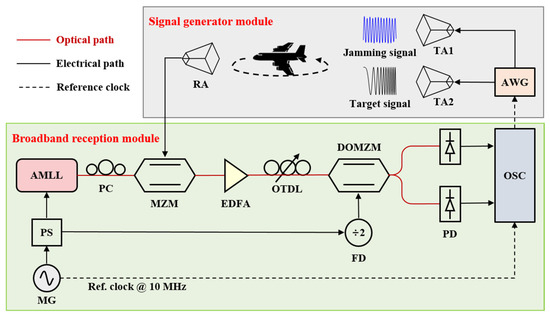
Figure 2.
The signal generator and broadband reception modules for bandwidth enhancement in radar active jamming suppression scheme.
3.1. Signal Generator Module
In the signal generator module, the arbitrary waveform generator (AWG, Keysight, M8152A) contains two channels, one generating the target signal and the other the jamming signal. We adopted a linear frequency modulation (LFM) signal as the target signal. The SMSP noise was used as the jamming signal. The jamming signal and the target signal were transmitted through transmitting antenna 1 (TA1, A-INFOMW, LB-90-20-C-SF) and 2 (TA2, A-INFOMW, LB-90-20-C-SF), respectively. Then, the transmitted signal was reflected by a moving target placed on a rotating platform.
In radar systems, LFM signals have gained widespread application owing to the superior target detection performance afforded by their wide pulse widths and large bandwidths. This work primarily focuses on exploring methods for the suppression of SMSP noise jamming specifically for LFM signals. The LFM signal can be expressed in the following form:
where is the rectangular function, is the pulse width, is the center frequency, and is the signal bandwidth. To form SMSP jamming, a jammer initially intercepts the radar’s LFM signal and performs time-domain compression. Subsequently, it concatenates multiple repetitions of these compressed segments. This process preserves the overall duration of the jamming signal, but each embedded sub-pulse features a modulation slope that is a multiple of the target echo’s slope. Consequently, the SMSP noise jamming can be expressed as [26]:
where is the number of sub-pulses. In an active jamming scenario, assuming the jammer and target are co-located and ignoring the effects of other noise, the transmitted signal can be expressed as:
where and are the gain factors of the target and jamming signals, respectively.
3.2. Broadband Reception Module
In the broadband reception module, the echo signals received through receiving antenna (RA, A-INFOMW, LB-20180H-SF) are modulated on a 20 GSa/s optical pulse train by a Mach–Zehnder modulator (MZM, EOSpace, AX-OMVS-40-PFA-PFA-LV). The optical pulse train is generated by an actively mode-locked laser (AMLL, Calmar, PSL-10-TT). To compensate for power attenuation, the customized erbium-doped fiber amplifier (EDFA, PMEDFA-C-BA-15-FA-M) amplifies the power of the modulated optical pulse train. The dual output Mach–Zehnder modulator (DOMZM, EOSpace, AX-1×2-OMSS-20-PFA-PFA-LV) is used as an optical switch to demultiplex the modulated optical pulse signal into two channels with a sampling rate of 10 GS/s. The accurate switching function of the DOMZM relies on the perfect matching of optical and electrical signals, which is achieved by tuning the length of the delay in the optical tunable delay line (OTDL, General Photonics, VDL-001-15-33). The demultiplexed optical pulse trains are then converted into electrical signals by two photodetectors (PD, EOT, ET-3500F) and digitized by an oscilloscope (OSC, Keysight, DSO-S 804A) with a bandwidth of 8 GHz. A microwave generator (MG, Keysight, E8257D) outputs a 20 GHz signal that is divided into two paths using a power splitter (PS, Talent Microwave, RS2W04260-S). One path drives the AMLL, resulting in a 20 GSa/s optical sampling rate. The second path’s signal is transferred to 10 GHz by a frequency divider (FD, RF Bay, FPS-2-20) to serve as the optical switch drive signal. For system synchronization, both the OSC and the AWG utilize the MG’s 10 MHz reference output as their reference clock. Finally, the digital signal is processed with pulse compression to obtain one-dimensional range profiles of the target. Figure 3 shows the LFM and SMSP echo signals received by the broadband receiver module. These signals have a period of 0.4 μs and a pulse width of 0.3 μs. The number of sub-pulses in the SMSP signal is 3.
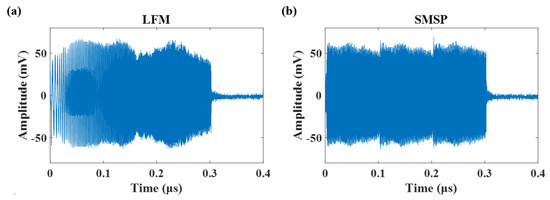
Figure 3.
(a) LFM and (b) SMSP echo signals after passing through broadband reception module.
We will now illustrate the pulse compression process using LFM signals as an example. For simplicity, assume two targets are located at ranges and from the radar. The radar transmits LFM signals towards them with respective bandwidths and (where ). Thus, the two transmitted signals can be represented as:
where and represent the amplitudes of the two transmitted signals, respectively. The term represents the frequency modulation rate for the signal transmitted towards target 1, while is the frequency modulation rate for the signal transmitted towards target 2. Consequently, the received radar echo signal is given by:
where and are the respective time delays from the target and radar for targets 1 and 2, and is the velocity of light in vacuum. For simplicity, noise is ignored. Subsequently, matched filtering is utilized to implement pulse compression. This matched filtering operation yields a narrow output pulse, thereby enhancing the resolution of the range, while simultaneously preserving the energy advantage of a wide transmitted pulse. The matched filter is designed to be matched to an LFM signal with bandwidth . Typically, its impulse response is the time-reversed conjugate of the reference signal. We set the reference signal as follows:
Therefore, the matched filter can be expressed as:
Hence, the output after pulse compression is given by:
where and denote the outputs of the matched filter corresponding to the echoes from target 1 and target 2, respectively. Next, we will analyze the pulse compression results for these two different bandwidth echoes separately. After pulse compression, two peaks emerge at times and , with respective amplitudes and . The calculation for the peak amplitude is:
where denotes the amplitude of the target signal. The equation above shows that the peak amplitude of the pulse compression output for the target 1 echo is related to the signal’s amplitude and pulse width. Additionally, the calculation for the peak amplitude is given by:
where denotes the amplitude of the jamming signal. As seen from the equation, while the peak amplitude for the target 2 echo after pulse compression depends on its signal amplitude and pulse width, it suffers from attenuation caused by the bandwidth mismatch. This loss factor is approximated by . This implies that the larger the difference between and , the more suppressed peak becomes relative to .
3.3. CNN Module
In the CNN module, we use the modified U-net as the jamming suppression model, as shown in Figure 4. This structure was modified from the fully convolutional U-net [27], which is typically used for image segmentation tasks. In accordance with the U-net strategy, the modified U-net model is divided into four down-sampling stages from top to bottom. The length of input and output sequences of the modified U-net model are , located at the first stage. The sequence lengths in the second to fourth down-sampling stages are , , and , respectively. In addition, we set the kernel size of the convolutional and pooling layers to during the subsequent processing stages. Different to the traditional U-net model, dense connections are introduced to achieve feature fusion across different scales, which are illustrated by the red curve at the bottom left of Figure 4. The “D.S. conv.” represents convolutions. The traditional U-net model performs down-sampling using max pooling (stride = 2). The modified U-net in this work fuses the information down-sampled by the convolution (stride = 2 or 4) with the information down-sampled by the following two layers via max pooling. This design allows the network to leverage information from earlier convolutional layers, addressing the vanishing gradient issue, facilitating more comprehensive feature extraction, and ultimately boosting the network’s information gathering capacity. Additionally, each layer consists of a convolution and a ReLU activation function. The number of feature channels for the four down-sampling layers are 16, 32, 64, and 128, respectively. Conversely, the bottom-up up-sampling is implemented through deconvolution. In the final layer, a convolution is used to map 16 feature vectors to the desired number of classes.
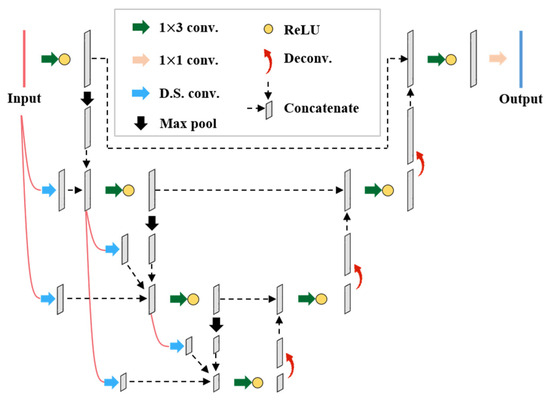
Figure 4.
Modified U-net model.
The modified U-net is a deep neural network that functions as a complex composite function, formed by combining the traditional U-net model with dense connections. Within the traditional U-net model, the left path handles encoding and down-sampling, while the right path performs decoding and up-sampling. Feature maps are passed across via skip connections located centrally. The model utilizes max pooling layers for n instances of down-sampling, extracting feature maps at each stage. Similarly, it uses deconvolution layers for n instances of up-sampling to restore the original input dimensions. Its mathematical model is described by the following equations:
where is the output of the down-sampling layer, is the function applied by the max-pooling layer, denotes the output of the up-sampling layer, signifies the function of the up-sampling layer, and represents the skip connection function. Finally, indicates the encoding layer, and indicates the decoding layer. For a dense connection architecture, the mathematical model can be expressed as [28]:
where donate the output of the layer, which is typically obtained from the output of the previous layer and by a convolution and a mapping .
4. Results and Discussion
4.1. Results of Pulse Compression
To verify the effectiveness of our proposed scheme under ultra-low SJR conditions, we adjusted the amplitude of the AWG to ensure an output SJR of −30 dB. Pulse compression was then performed on the digitized data output by the broadband reception module. As shown in Figure 5a–d, we observed the effect of increasing the target signal bandwidth on the pulse compression results. The one-dimensional range profiles obtained by pulse compression are the projection of scatterers of a target to the radar’s line of sight, and the target can be divided into multiple range cells along the radar’s line of sight. Because the targets are placed on a uniformly rotating platform and echo signals are collected randomly, this can lead to certain differences in the relative positions of the target signal and the jamming signal. Due to the limitations of the jammer’s maximum transmission power and bandwidth [29], the jamming bandwidth does not increase indefinitely. In practical scenarios, the typical jamming bandwidth ranges from 30 to 150 MHz [30]. Therefore, a jamming signal bandwidth of 0.2 GHz is used for analysis. When the target signal bandwidth is only 0.3 GHz, the target signal is completely overwhelmed by the strong jamming after pulse compression. This occurs because the difference in bandwidth between the target signal and jamming signal is small, and the jamming power significantly exceeds that of the target. Upon increasing the target signal bandwidth to 0.7 GHz, although the target remained indiscernible, a decrease in the jamming signal’s amplitude became noticeable. Further increasing the target signal bandwidth to 1.8 GHz allowed the target signal’s peak amplitude to surpass the jamming, enabling clear target identification. On the one hand, as the bandwidth of the target signal increases, the bandwidth ratio between the target signal and the jamming signal also increases. As a result, their correlation decreases during pulse compression, leading to a reduction in the peak of the jamming signal. On the other hand, increasing the bandwidth improves the resolution of the target signal, which reduces the pulse width after pulse compression, thereby increasing the amplitude of the target signal. For these two reasons, the amplitude of the jamming signal gradually decreases and the target signal gradually comes to the fore. Figure 5e demonstrates the combined influence of the SJR and target signal bandwidth on the IF. It shows that for a fixed target signal bandwidth, variations in SJR have minimal impact on the IF value. However, as the target signal bandwidth increases, the IF value significantly rises before gradually saturating. The underlying mechanism is that pulse compression fundamentally measures the correlation between signals, which is primarily determined by the ratio of their bandwidths and is less dependent on the SJR.
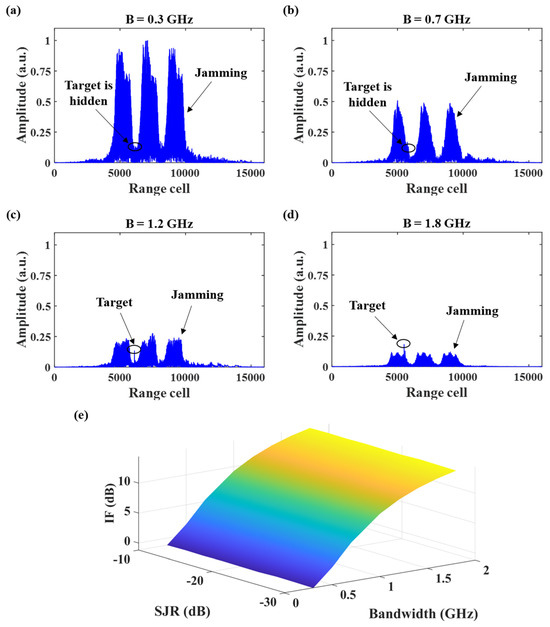
Figure 5.
Pulse compression results of the broadband reception system output with the bandwidths of (a) 0.3 GHz, (b) 0.7 GHz, (c) 1.2 GHz, and (d) 1.8 GHz. (e) Effect of different SJR and target signal bandwidth on IF.
To evaluate the SMSP jamming suppression capability of the proposed bandwidth enhancement method, a comparative analysis was conducted based on the ICA [7] and ESP methods [15]. Table 1 presents the IF results for these methods at an input SJR of −30 dB. As the target signal bandwidth is increased from 0.3 GHz to 1.8 GHz, the bandwidth enhancement method achieves an IF of 16.86 dB. This represents an improvement of 12.61 dB and 8.35 dB over the ICA and ESP methods, respectively. These findings clearly demonstrate the superior jamming suppression performance of the bandwidth enhancement method compared to the other two methods. Furthermore, the preliminary jamming suppression achieved via bandwidth enhancement can effectively alleviate the data fitting burden for subsequent neural network processing.

Table 1.
Comparison of results of different methods in jamming suppression.
4.2. Results of CNN
To further investigate the impact of different target signal bandwidths on the CNN, four complex models were selected as targets, as shown in Figure 6a–d. Specifically, the aircraft depicted in Figure 2 is representative of these four models. Subsequently, we used these four models to collect experimental echo data across various target signal bandwidths. The bandwidth of the jamming signals is 0.2 GHz, while target signals vary in bandwidth from 0.3 GHz to 1.8 GHz, with increments of 0.2 GHz. Meanwhile, the bandwidth of each type of signal ranges from 10 to 12 GHz. We use AWG to generate 4000 sets of data in 8 bandwidths, each containing 500 sets of data. For each bandwidth, 80% of the data is allocated for training, and the remaining 20% is used for testing. Before data are fed into the CNN, they are processed by pulse compression and then normalized. We use an Adam optimizer with an initial learning rate of 0.001 for back propagation. The training process is completed on a personal computer with Intel Core i7-10510U and NVIDIA GeForce MX250 GPUs. As depicted in Figure 6e, the network’s training and validating losses steadily decrease with the increase in training epochs, ultimately converging to a value of 0.01 without evidence of overfitting. This confirms that the CNN model is thoroughly trained.
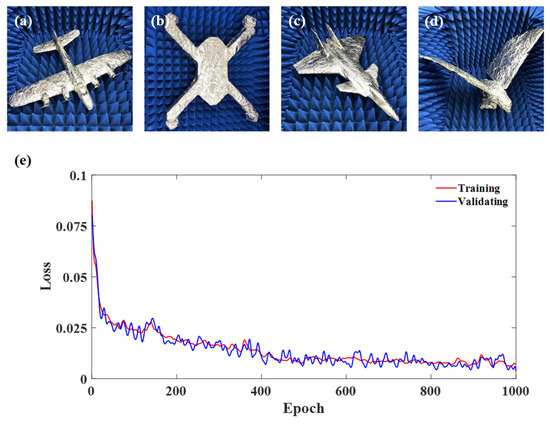
Figure 6.
(a–d) Pictures of the four complex target models. (e) Loss curves for network training and validating.
The network output results are shown in Figure 7a–d. When the bandwidth of the target signal is 0.3 GHz, the neural network fails to converge effectively, resulting in a disorganized network output. Upon increasing the target signal bandwidth to 0.7 GHz, the network’s output demonstrates a significant improvement over the results obtained with a 0.3 GHz bandwidth, although it does not yet precisely match the ground truth. The primary reason for this enhancement is that the increased target signal bandwidth leads to a higher target-to-jamming bandwidth ratio, initially contributing to jamming suppression. As a result, the SJR of the input data fed into the neural network is enhanced, simplifying the network’s data fitting task. Additionally, when the target signal bandwidth reaches 1.8 GHz, the close correspondence between the network output and the ground truth signifies an excellent signal reconstruction quality.
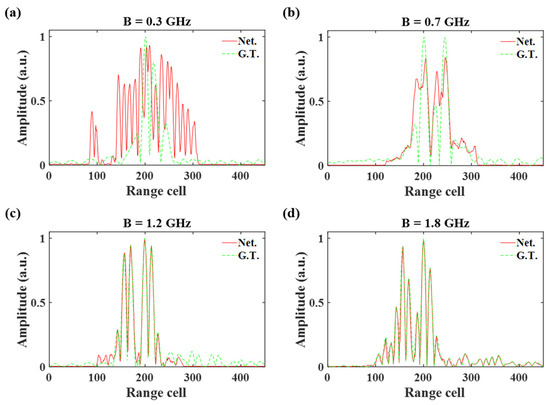
Figure 7.
Pulse compression results of the network output (Net.) and ground truth (G.T.) when the bandwidth is (a) 0.3 GHz, (b) 0.7 GHz, (c) 1.2 GHz, and (d) 1.8 GHz.
4.3. Comparison of Pulse Compression and CNN
Figure 8 compares the IF before and after CNN processing under an input SJR of −30 dB. Firstly, the black curve represents the results after the pulse compression stage (i.e., before CNN processing). This curve reveals a trend where the IF increases as the target signal bandwidth increases. However, this improvement becomes less significant after the bandwidth reaches 1.2 GHz, with the IF value stabilizing at ~15 dB. The reason for this is that simply increasing the target signal bandwidth for pulse compression cannot completely eliminate jamming, leaving substantial residual components. This indicates that relying solely on bandwidth enhancement for jamming suppression is insufficient, and further increasing the bandwidth also leads to higher hardware costs. Secondly, the red curve illustrates the performance enhancement achieved by the CNN following the initial pulse compression. The difference between the two curves is the amount of improvement in the IF when using the CNN alone. As observed, the IF becomes negative when the target signal bandwidth is below 0.5 GHz. This is primarily because under these target signal bandwidth conditions, the correlation between the target signal and the jamming signal is relatively high, preventing effective jamming suppression by pulse compression. Consequently, the SJR input to the CNN model is low. In this way, the neural network fails to converge properly during the process of extracting target signal features. As a result, the neural network’s output deviates significantly from the expected values, leading to a negative IF. However, as the target signal bandwidth increases to 0.7 GHz, the CNN demonstrates significantly improved jamming suppression, achieving a performance comparable to that of a 1.8 GHz bandwidth signal processed without the CNN. Moreover, at a bandwidth of 1.2 GHz, CNN processing yields an IF improvement of ~27 dB, building upon the pulse compression process, and eventually reaching about 42 dB. Beyond this point, further increases in target signal bandwidth result in minimal changes to the IF, indicating a gradual approach to saturation. This suggests the neural network is operating near its optimal performance level, effectively restoring the target signal and emphasizing its critical features. Consequently, selecting 1.2 GHz as the target signal bandwidth offers strong jamming suppression while effectively managing system hardware costs. The results above demonstrate that both bandwidth enhancement and the CNN are crucial for jamming suppression. Bandwidth enhancement alone encounters performance limitations. Meanwhile, the CNN alone fails to perform effectively under −30 dB input SJR conditions. Therefore, both techniques are essential and mutually required for effective jamming suppression in −30 dB SJR scenarios.
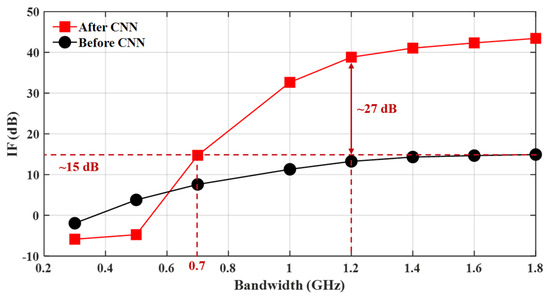
Figure 8.
The IF results before and after CNN processing when the input SJR is −30 dB.
4.4. Results of Time-Frequency Domain
For a more visual understanding of Figure 8, we present the results before and after network jamming suppression with time–frequency plots for when the target signal bandwidth is 1 GHz and 1.8 GHz, respectively, as shown in Figure 9. With the CNN’s assistance, 1 GHz is the smallest bandwidth that achieves better jamming suppression than a 1.8 GHz bandwidth system without a CNN. In addition to the target and jamming signals, some spurs also arise due to channel mismatch in the broadband reception module [31]. The primary cause of channel mismatch is the difference in physical path lengths between the various channels in the broadband reception module, which leads to a time mismatch effect. As observed in the time-frequency plot, this time mismatch effect generates spurious frequency components at , where denotes the signal frequency and represents the sampling rate. A comparison between Figure 9a and b reveals that CNN processing significantly suppresses the jamming signal, allowing the target signal to be clearly visualized while also substantially reducing background noise amplitude. Similar outcomes are observed when comparing Figure 9c and Figure 9d. However, a difference arises because the initial suppression for the 1.8 GHz target signal bandwidth after pulse compression is more effective than for the 1 GHz signal, thus easing the data fitting burden on the neural network. Consequently, the target signal intensity in Figure 9d after CNN processing exceeds that in Figure 9b. Additionally, a comparison of Figure 9b and Figure 9c, even with a 1 GHz bandwidth, the CNN-processed signal exhibits more superior jamming suppression effects than the CNN-unprocessed 1.8 GHz signal. This indicates that building upon the bandwidth enhancement methods processing, the CNN provides a more effective overall result.

Figure 9.
Time–frequency plots (a) before and (b) after CNN jamming suppression for bandwidth of 1 GHz. Time–frequency plots (c) before and (d) after CNN jamming suppression when the bandwidth is 1.8 GHz.
4.5. Comparison of Results with Traditional U-Net
Figure 10a shows the jamming suppression results of the modified U-net for SMSP noise. As a whole, the IF rises with increasing bandwidth. When the bandwidth increases from 0.5 GHz to 0.7 GHz, there is a sudden jump in IF. When the bandwidth is increased to 1.2 GHz, the IF continues to increase, but at a slower rate. Increasing the bandwidth further will cause the IF to become saturated. Specifically, the suppression effect is limited when the target signal bandwidths are 0.3 GHz and 0.5 GHz and the input SJR is less than −25 dB and −27 dB, respectively. However, when the bandwidth exceeds 0.7 GHz, an effective suppression can be achieved even when the input SJR is −30 dB. It can be observed that the IF shows a decreasing trend after reaching its maximum value for the same bandwidth condition. This is because the network output has already reached its maximum value. If the input SJR continues to increase, the output remains unchanged, resulting in a decrease in the IF. Furthermore, as the target signal bandwidth increases from 0.3 GHz to 1.4 GHz, the SJR corresponding to the maximum neural network output decreases by ~12 dB, while the maximum IF improves by ~15 dB. Meanwhile, when the target signal bandwidth is 1.2 GHz, an IF enhancement of ~40 dB is achieved with an input SJR of −30 dB. The jamming suppression results of the traditional U-net are shown in Figure 10b. It can be seen that the two networks exhibit a similar trend in jamming suppression. However, compared with the modified U-net, the performance of the traditional U-net is degraded. Specifically, when the target signal bandwidth increases from 0.3 GHz to 1.4 GHz, for the traditional U-net, the SJR corresponding to its maximum network output decreases by ~10 dB, and its maximum IF increases by ~10 dB. These values are approximately 2 dB and 5 dB lower than those achieved by the modified U-net, respectively. Furthermore, at a 1.2 GHz bandwidth and an input SJR of −30 dB, the IF improvement achieved by the traditional U-net is ~35 dB, which is 5 dB lower than the improvement obtained with the modified U-net. This indicates that the dense connections enable the modified U-net model to enhance its feature extraction capability during the encoding stage, resulting in superior jamming suppression performance. Furthermore, while the minimum SJR in our work is −30 dB, this already represents a highly challenging jamming environment. The trends observed in Figure 10 suggest that if the SJR is to be further reduced, the IF value would likely decrease and could potentially become negative. Therefore, future work should focus on designing neural network architectures better adapted to such complex environments for more effective jamming suppression.
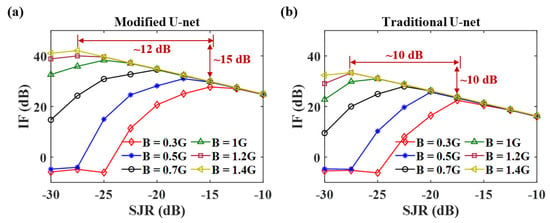
Figure 10.
As the bandwidth and SJR increase, the results of IF for both (a) the modified U-net and (b) the traditional U-net improve.
Compared to other methods that typically achieve jamming suppression at input SJRs of −10 dB [19] and 5 dB [20], our approach successfully suppresses jamming even under −30 dB input SJR conditions. Furthermore, when employing the CNN, the jamming suppression performance at a 0.7 GHz bandwidth is comparable to that achieved without the CNN at 1.8 GHz. Moreover, the IF gradually saturates when the bandwidth exceeds 1.2 GHz. Selecting a bandwidth of 1.2 GHz provides an effective balance between jamming suppression performance and reduced system costs. Therefore, our investigation into a potential CNN-assisted bandwidth enhancement scheme offers valuable guidance for selecting an appropriate target signal bandwidth in practical radar active jamming suppression scenarios. However, despite achieving excellent jamming suppression results, there is still room for improvement. Firstly, all data used in this paper were collected in a controlled laboratory environment. Real-world application will involve environmental clutter, potentially affecting suppression performance. Consequently, future work should focus on further improving the model architecture, such as by incorporating advanced frameworks like transformer models, to better capture these complex signal features. Secondly, the experimental validation in this paper focuses on SMSP jamming signals. However, real-world environments often present a variety of jamming signal types. Thus, further exploration is required to develop more robust neural network models capable of suppressing diverse jamming signals encountered in operational environments.
5. Conclusions
We have proposed a CNN-assisted scheme using bandwidth enhancement to effectively realize radar active jamming suppression in −30 dB input SJR conditions. Increasing the target signal bandwidth reduces the correlation between the target signal and the jamming signal, thereby yielding higher-quality target range profiles. Building on the bandwidth enhancement method, the modified CNN can effectively suppress jamming even in −30 dB SJR scenarios. When the bandwidth increases to 1.2 GHz, the IF without CNN processing rises to ~15 dB and gradually saturates. Based on the bandwidth enhancement method, the jamming suppression effects after CNN processing improves by ~27 dB compared to the CNN-unprocessed case. As the bandwidth continues to increase, the improvement of the CNN-processed IF slows down. Finally, the IF reaches ~40 dB when the input SJR is −30 dB. We believe that the proposed scheme will provide technological support for radars to detect, track, and recognize targets in ultra-low SJR environments.
Author Contributions
Conceptualization, L.Z., X.Z. and S.X.; methodology, L.Z., X.Z. and S.X.; software, L.Z.; validation, L.Z., X.Z., S.X., M.C., W.L., Z.L. and W.Z.; formal analysis, L.Z., X.Z. and S.X.; investigation, L.Z.; resources, L.Z.; data curation, L.Z.; writing—original draft preparation, L.Z.; writing—review and editing, L.Z., X.Z. and S.X.; visualization, L.Z., X.Z. and S.X.; supervision, M.C., W.L., Z.L. and W.Z.; project administration, S.X. and W.Z.; funding acquisition, S.X. and W.Z. All authors have read and agreed to the published version of the manuscript.
Funding
This research was funded in part by the National Natural Science Foundation of China, grant numbers T2225023 and 62205203, and in part by the Shanghai Aerospace Technology Renovation Fund, grant number USCAST2022-37.
Data Availability Statement
The data that support the findings of this study are available from the corresponding author upon reasonable request.
Conflicts of Interest
The authors declare no conflicts of interest.
References
- Qu, Q.; Wei, S.; Liu, S.; Liang, J.; Shi, J. JRNet: Jamming recognition networks for radar compound suppression jamming signals. IEEE Trans. Veh. Technol. 2020, 69, 15035–15045. [Google Scholar] [CrossRef]
- Calatrava, H.; Tang, S.; Closas, P. Advances in Anti-Deception Jamming Strategies for Radar Systems: A Survey. arXiv 2025, arXiv:2503.00285. [Google Scholar]
- Li, N.; Zhang, Y. A survey of radar ECM and ECCM. IEEE Trans. Aerosp. Electron. Syst. 1995, 31, 1110–1120. [Google Scholar]
- Lan, L.; Xu, J.; Liao, G.; Zhang, Y.; Fioranelli, F.; So, H.C. Suppression of mainbeam deceptive jammer with FDA-MIMO radar. IEEE Trans. Veh. Technol. 2020, 69, 11584–11598. [Google Scholar] [CrossRef]
- Tian, D.; Wang, C.; Ren, W.; Liang, Z.; Liu, Q. ECCM scheme for countering main-lobe interrupted sampling repeater jamming via signal reconstruction and mismatched filtering. IEEE Sens. J. 2023, 23, 13261–13271. [Google Scholar] [CrossRef]
- Liu, Z.; Liao, G.; Yang, Z. Time variant RFI suppression for SAR using iterative adaptive approach. IEEE Geosci. Remote Sens. Lett. 2013, 10, 1424–1428. [Google Scholar] [CrossRef]
- Zhou, F.; Tao, M.; Bai, X.; Liu, J. Narrow-band interference suppression for SAR based on independent component analysis. IEEE Trans. Geosci. Remote Sens. 2013, 51, 4952–4960. [Google Scholar] [CrossRef]
- Li, N.; Lv, Z.; Guo, Z.; Zhao, J. Time-domain notch filtering method for pulse RFI mitigation in synthetic aperture Radar. IEEE Geosci. Remote Sens. Lett. 2021, 19, 4013805. [Google Scholar] [CrossRef]
- Fu, Z.; Zhang, H.; Zhao, J.; Li, N.; Zheng, F. A modified 2-D notch filter based on image segmentation for RFI mitigation in synthetic aperture radar. Remote Sens. 2023, 15, 846. [Google Scholar] [CrossRef]
- Zhao, J.; Liao, G.; Xing, H.; Jia, B.; Liu, S.; Wang, Y.; Zhang, X. Range-frequency domain iterative notch filtering method for RFI mitigation in SAR. IEEE Geosci. Remote Sens. Lett. 2024, 21, 4010305. [Google Scholar] [CrossRef]
- Wang, Z.; Li, J.; Yu, W.; Luo, Y.; Zhao, Y.; Yu, Z. Energy function-guided histogram analysis for interrupted sampling repeater jamming suppression. Electron. Lett. 2023, 59, e12778. [Google Scholar] [CrossRef]
- Abdalla, A.; Ramadan, M.; Liao, Y.; Zhou, S. An adaptive filtering algorithm in pulse-doppler radar for counteracting range-velocity jamming. Int. J. Electron. 2022, 109, 1695–1713. [Google Scholar] [CrossRef]
- Xu, W.; Xing, W.; Fang, C.; Huang, P.; Tan, W. RFI suppression based on linear prediction in synthetic aperture radar data. IEEE Geosci. Remote Sens. Lett. 2021, 18, 2127–2131. [Google Scholar] [CrossRef]
- Li, N.; Lv, Z.; Guo, Z. Observation and mitigation of mutual RFI between SAR satellites: A case study between Chinese GaoFen-3 and European Sentinel-1A. IEEE Geosci. Remote Sens. Lett. 2022, 60, 5112819. [Google Scholar] [CrossRef]
- Zhou, F.; Wu, R.; Xing, M.; Bao, Z. Eigensubspace-based filtering with application in narrow-band interference suppression for SAR. IEEE Geosci. Remote Sens. Lett. 2007, 4, 75–79. [Google Scholar] [CrossRef]
- Feng, J.; Zheng, H.; Deng, Y.; Gao, D. Application of subband spectral cancellation for SAR narrow-band interference suppression. IEEE Geosci. Remote Sens. Lett. 2012, 9, 190–193. [Google Scholar] [CrossRef]
- Zhang, S.; Xing, M.; Guo, R.; Zhang, L.; Bao, Z. Interference suppression algorithm for SAR based on time–frequency transform. IEEE Trans. Geosci. Remote Sens. 2011, 49, 3765–3779. [Google Scholar] [CrossRef]
- Minar, M.R.; Naher, J. Recent advances in deep learning: An overview. arXiv 2018, arXiv:1807.08169. [Google Scholar]
- Gao, S.; Yang, X.; Lan, T.; Han, B.; Sun, H.; Yu, Z. Radar main-lobe jamming suppression and identification based on robust whitening blind source separation and convolutional neural networks. IET Radar Sonar Navig. 2022, 16, 552–563. [Google Scholar] [CrossRef]
- Hua, Q.; Zhang, Y.; Wei, C.; Ji, Z.; Jiang, Y.; Wang, Y.; Xu, D. A self-supervised method based on CV-MUNet++ for active jamming suppression in SAR images. IEEE Trans. Geosci. Remote Sens. 2023, 61, 5209516. [Google Scholar] [CrossRef]
- Jiang, Y.; Yang, Y.; Zhang, W.; Guo, L. Deep learning-based active jamming suppression for radar main lobe. IET Signal Process. 2024, 2024, 3179667. [Google Scholar] [CrossRef]
- Shang, S.; He, K.; Wang, Z.; Yang, T.; Liu, M.; Li, X. Sea clutter suppression method of HFSWR based on RBF neural network model optimized by improved GWO algorithm. Comput. Intell. Neurosci. 2020, 2020, 8842390. [Google Scholar] [CrossRef] [PubMed]
- Shen, H.; George, D.; Huerta, E.; Zhao, Z. Denoising gravitational waves with enhanced deep recurrent denoising auto-encoders. In Proceedings of the ICASSP 2019—2019 IEEE International Conference on Acoustics, Speech and Signal Processing (ICASSP), Brighton, UK, 12–17 May 2019; pp. 3237–3241. [Google Scholar]
- Liu, X.; Zhang, T.; Shi, Q.; Yu, X.; Cui, G.; Kong, L. LPI radar waveform design with desired cyclic spectrum and pulse compression properties. IEEE Trans. Veh. Technol. 2023, 72, 6789–6793. [Google Scholar] [CrossRef]
- Yang, Z.; Du, W.; Liu, Z.; Liao, G. WBI suppression for SAR using iterative adaptive method. IEEE J. Sel. Top. Appl. Earth Observ. 2016, 9, 1008–1014. [Google Scholar] [CrossRef]
- Zeng, L.; Chen, H.; Zhang, Z.; Liu, W.; Wang, Y.; Ni, L. Cutting compensation in the time-frequency domain for smeared spectrum jamming suppression. Electronics 2022, 11, 1970. [Google Scholar] [CrossRef]
- Ronneberger, O.; Fischer, P.; Brox, T. U-Net: Convolutional networks for biomedical image segmentation. In Proceedings of the Medical image computing and computer-assisted intervention–MICCAI 2015: 18th international conference, Munich, Germany, 5–9 October 2015; pp. 234–241. [Google Scholar]
- Huang, G.; Liu, Z.; Van Der Maaten, L.; Weinberger, K.Q. Densely connected convolutional networks. In Proceedings of the IEEE Conference on Computer Vision and Pattern Recognition (CVPR), Honolulu, HI, USA, 21–26 July 2017; pp. 4700–4708. [Google Scholar]
- Giustiniano, D.; Schalch, M.; Liechti, M.; Lenders, V. Interference Suppression in Bandwidth Hopping Spread Spectrum Communications. In Proceedings of the 11th ACM Conference on Security & Privacy in Wireless and Mobile Networks (WiSec’18), Stockholm, Sweden, 18–20 June 2018; pp. 134–143. [Google Scholar]
- Fang, F.; Tian, Y.; Dai, D.; Xing, S. Synthetic aperture radar radio frequency interference suppression method based on fusing segmentation and inpainting networks. Remote Sens. 2024, 16, 1013. [Google Scholar] [CrossRef]
- Yang, G.; Zou, W.; Yu, L.; Chen, J. Influence of the sampling clock pulse shape mismatch on channel-interleaved photonic analog-to-digital conversion. Opt. Lett. 2018, 43, 3530–3533. [Google Scholar] [CrossRef]
Disclaimer/Publisher’s Note: The statements, opinions and data contained in all publications are solely those of the individual author(s) and contributor(s) and not of MDPI and/or the editor(s). MDPI and/or the editor(s) disclaim responsibility for any injury to people or property resulting from any ideas, methods, instructions or products referred to in the content. |
© 2025 by the authors. Licensee MDPI, Basel, Switzerland. This article is an open access article distributed under the terms and conditions of the Creative Commons Attribution (CC BY) license (https://creativecommons.org/licenses/by/4.0/).